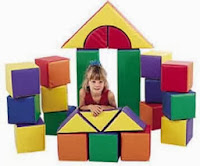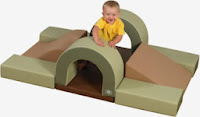 |
| Children's Factory Soft Tunnel Climber |
Ten years ago, when we began resourcing toys for our store, I was fascinated to discover the big oversized blocks and foam shapes from Children’s Factory. Now, I grew up playing with blocks, but mostly wooden unit blocks. The biggest size of those was about 6 inches. They were fun for building structures you could use to play with your other toys. You could build a house that would accommodate 5-inch figures or 6-7-inch cars. The larger sizes of these block sets were usually preferred for spanning roofs or just building taller structures.
 |
| 21-Piece Soft Block Set |
Plus, these blocks and foam shapes can be assembled as climbers with the potential for the same gross motor climbing fun of a playground construction, but they’re inside, and they’re soft. There are ramps to ascend, tunnels to navigate, and soft perches for sitting and looking out around the room. Take Children’s Factory’s Soft Tunnel Climber, for example. There’s a tunnel in the middle, a ramp up on one side and two steps up on the other. Early crawlies can explore the perimeter, play in the tunnel and eventually climb to the top, via their choice of steps or ramps.
 |
| Children's Factory Tunnel Labyrinth
On the big extreme, there’s
the Children’s Factory Tunnel Labyrinth. Four tunnels make it like a quadruple
Soft Tunnel Climber. These are great for accommodating bigger groups of kids.
|
 |
| Cozy Woodland Hideout |
Since we’ve been carrying the Children’s Factory line, we’ve
seen them add new climber models, as well as new color schemes. While the early
soft play pieces from Children’s Factory were bright primary colors with a few
pastel variations, one of the recent changes in the Children’s Factory line has
been the introduction of soft, earth-tone colors in their Cozy Woodland Collection. Most of their climbers and foam shapes are now available in either
color pallet.
Now, the creative and imaginative potential of little unit blocks
is still as great as it ever was. Frank Lloyd Wright and Frank Geary credit
unit blocks with helping to give them a first step in their architectural
careers. Blocks, whether huge or small scale, can inspire young minds. But the
scale of these larger foam shapes changes the nature of block play, and with it
the pretend play and creative opportunities.
Chief Imagination Officer








